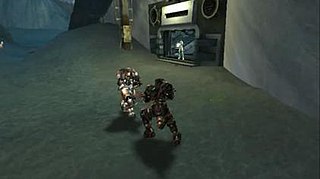Related Research Articles

ELIZA is an early natural language processing computer program created from 1964 to 1967 at MIT by Joseph Weizenbaum. Created to explore communication between humans and machines, ELIZA simulated conversation by using a pattern matching and substitution methodology that gave users an illusion of understanding on the part of the program, but had no representation that could be considered really understanding what was being said by either party. Whereas the ELIZA program itself was written (originally) in MAD-SLIP, the pattern matching directives that contained most of its language capability were provided in separate "scripts", represented in a lisp-like representation. The most famous script, DOCTOR, simulated a psychotherapist of the Rogerian school, and used rules, dictated in the script, to respond with non-directional questions to user inputs. As such, ELIZA was one of the first chatterbots and one of the first programs capable of attempting the Turing test.

Kevin Warwick is an English engineer and Deputy Vice-Chancellor (Research) at Coventry University. He is known for his studies on direct interfaces between computer systems and the human nervous system, and has also done research concerning robotics.

A chatbot is a software application or web interface that is designed to mimic human conversation through text or voice interactions. Modern chatbots are typically online and use generative artificial intelligence systems that are capable of maintaining a conversation with a user in natural language and simulating the way a human would behave as a conversational partner. Such chatbots often use deep learning and natural language processing, but simpler chatbots have existed for decades.
The Loebner Prize was an annual competition in artificial intelligence that awarded prizes to the computer programs considered by the judges to be the most human-like. The prize is reported as defunct since 2020. The format of the competition was that of a standard Turing test. In each round, a human judge simultaneously held textual conversations with a computer program and a human being via computer. Based upon the responses, the judge would attempt to determine which was which.

Hugh Loebner was an American inventor and social activist, who was notable for sponsoring the Loebner Prize, an embodiment of the Turing test. Loebner held six United States Patents, and was also an outspoken advocate for the decriminalization of prostitution.
Jabberwacky is a chatterbot created by British programmer Rollo Carpenter. Its stated aim is to "simulate natural human chat in an interesting, entertaining and humorous manner". It is an early attempt at creating an artificial intelligence through human interaction.

Robby Garner is an American natural language programmer and software developer. He won the 1998 and 1999 Loebner Prize contests with the program called Albert One. He is listed in the 2001 Guinness Book of World Records as having written the "most human" computer program.
A.L.I.C.E., also referred to as Alicebot, or simply Alice, is a natural language processing chatterbot—a program that engages in a conversation with a human by applying some heuristical pattern matching rules to the human's input. It was inspired by Joseph Weizenbaum's classical ELIZA program.
The minimum intelligent signal test, or MIST, is a variation of the Turing test proposed by Chris McKinstry in which only boolean answers may be given to questions. The purpose of such a test is to provide a quantitative statistical measure of humanness, which may subsequently be used to optimize the performance of artificial intelligence systems intended to imitate human responses.
The Verbot (Verbal-Robot) was a popular chatbot program and artificial intelligence software development kit (SDK) for Windows and web.
Fred, or FRED, was an early chatterbot written by Robby Garner.
There are a number of competitions and prizes to promote research in artificial intelligence.
Kenneth Mark Colby was an American psychiatrist dedicated to the theory and application of computer science and artificial intelligence to psychiatry. Colby was a pioneer in the development of computer technology as a tool to try to understand cognitive functions and to assist both patients and doctors in the treatment process. He is perhaps best known for the development of a computer program called PARRY, which mimicked a person with paranoid schizophrenia and could "converse" with others. PARRY sparked serious debate about the possibility and nature of machine intelligence.

The computer game bot Turing test is a variant of the Turing test, where a human judge viewing and interacting with a virtual world must distinguish between other humans and video game bots, both interacting with the same virtual world. This variant was first proposed in 2008 by Associate Professor Philip Hingston of Edith Cowan University, and implemented through a tournament called the 2K BotPrize.
The confederate effect is the phenomena of people falsely classifying human intelligence as machine intelligence during Turing tests. For example, in the Loebner Prize during which a tester conducts a text exchange with one human and one artificial-intelligence chatbot and is tasked to identify which is which, the confederate effect describes the tester inaccurately identifying the human as the machine.
Eugene Goostman is a chatbot that some regard as having passed the Turing test, a test of a computer's ability to communicate indistinguishably from a human. Developed in Saint Petersburg in 2001 by a group of three programmers, the Russian-born Vladimir Veselov, Ukrainian-born Eugene Demchenko, and Russian-born Sergey Ulasen, Goostman is portrayed as a 13-year-old Ukrainian boy—characteristics that are intended to induce forgiveness in those with whom it interacts for its grammatical errors and lack of general knowledge.

The Turing test, originally called the imitation game by Alan Turing in 1950, is a test of a machine's ability to exhibit intelligent behaviour equivalent to, or indistinguishable from, that of a human. Turing proposed that a human evaluator would judge natural language conversations between a human and a machine designed to generate human-like responses. The evaluator would be aware that one of the two partners in conversation was a machine, and all participants would be separated from one another. The conversation would be limited to a text-only channel, such as a computer keyboard and screen, so the result would not depend on the machine's ability to render words as speech. If the evaluator could not reliably tell the machine from the human, the machine would be said to have passed the test. The test results would not depend on the machine's ability to give correct answers to questions, only on how closely its answers resembled those a human would give. Since the Turing test is a test of indistinguishability in performance capacity, the verbal version generalizes naturally to all of human performance capacity, verbal as well as nonverbal (robotic).
The Alan Turing Year, 2012, marked the celebration of the life and scientific influence of Alan Turing during the centenary of his birth on 23 June 1912. Turing had an important influence on computing, computer science, artificial intelligence, developmental biology, and the mathematical theory of computability and made important contributions to code-breaking during the Second World War. The Alan Turing Centenary Advisory committee (TCAC) was originally set up by Professor Barry Cooper
The following outline is provided as an overview of and topical guide to natural-language processing:
References
- ↑ Søren Gjellerup Christiansen "Techniques applied to pass the Turing Test" Archived 2007-09-14 at the Wayback Machine Master's Thesis
- ↑ "Albert is top talking computer". BBC News. BBC. 28 January 1999. Archived from the original on 24 July 2004. Retrieved 5 April 2008.
- ↑ "Computers get chattier". BBC News. BBC. 18 March 1999. Archived from the original on 14 July 2023. Retrieved 5 April 2008.
- ↑ "No contest". New Scientist. Reed Business Information Ltd. 30 January 1999. Archived from the original on 17 April 2008. Retrieved 5 April 2008.
- ↑ L. Caputo, R. Garner, P. Nathan. "FRED, Milton and Barry: the evolution of intelligent agents for the Web", Advances in intelligent systems, 1997. portal.acm.org
- ↑ R. Garner "Multifaceted Conversational Systems" Archived 2 April 2015 at the Wayback Machine , Colloquium on Conversational Systems, University of Surrey, 2005. Robitron.com